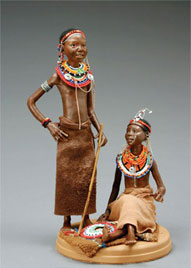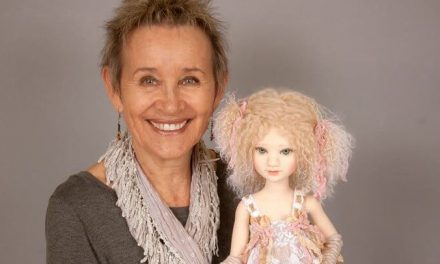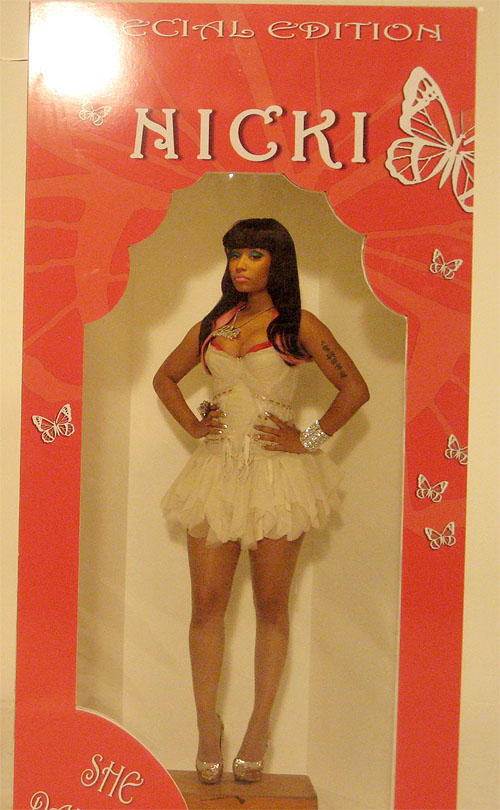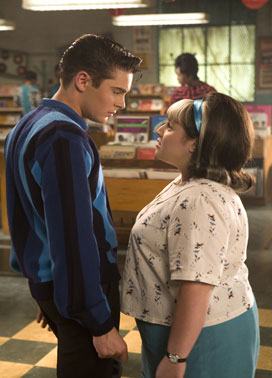Dolls have always been a part of Eva Wilson’s life, whether collecting or making them. Her interest is perhaps a hereditary trait passed on from her great-grandmother whom she is named after. Wilson’s great-grandmother was a dollmaker who owned a vast collection of dolls. Wilson’s interest in dolls peaked at an early age when a fascination with the human anatomy propelled her on a quest to create her own miniature “little people.”
As a child, her fascination with the human form sent her scuttling about in search of scraps she could shape into a doll. She recalls quite an impressive collection of dolls made from pipe cleaners, tissue and cloth that were created with increasing detail and precision. As she grew older, her skills improved considerably, and she began working on life-size scale models during her high school years. “I think I’ve always been fascinated with the human form, and I’ve often reflected on the odd coincidence that I was named after a dollmaker who happened to also be my great-grandmother,” says Wilson.
Remarkable as it sounds, Wilson is actually a completely self-taught dollmaker. That may sound implausible when you look at her work, but she does everything from sculpting to mold-making and casting. Before creating resin-based dolls, she would carve her creations out of wood. The early wood models started out at 1/12 scale. These were completely whittled out of a small block of pine with a regular utility knife. As time went on, Wilson expanded her choice of tools to include Japanese carving knives that she still uses to carve away clay.
While working with wood, Wilson produced more than 50 dollhouse-size wooden dolls with armature bodies. The largest of these wooden ball-jointed dolls stood approximately 70 cm tall and served as inspiration to continue work in a larger scale—with different materials. The timing was perfect to move on to resin because as Wilson points out, “The wood carving started to take a toll on my hands due to working for hours at a time, so I thought it was time to try something new.” She took some tips from Ryo Yoshida’s dollmaking book and learned to work with resin through trial and error. She laughs about her dedication, “I’m always thinking of my dolls and ways to improve them. In short, I’m always sculpting something!”
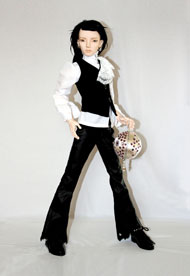 Early on she would start with sketches, which she used as guidelines to cut Styrofoam cores to size. These drawings served as templates to craft and mold her dolls. As she grew as an artist, she no longer needed drawings to work with an acute sense of proportion and scale. “I think with experience you just know where everything should go! I had been experimented with wigs, eyes and clothing but realized I was spreading myself too thin and decided to focus solely on the dolls,” Wilson says. That might explain the organic nature of the dolls she creates that she calls her “babies.”
Early on she would start with sketches, which she used as guidelines to cut Styrofoam cores to size. These drawings served as templates to craft and mold her dolls. As she grew as an artist, she no longer needed drawings to work with an acute sense of proportion and scale. “I think with experience you just know where everything should go! I had been experimented with wigs, eyes and clothing but realized I was spreading myself too thin and decided to focus solely on the dolls,” Wilson says. That might explain the organic nature of the dolls she creates that she calls her “babies.”
Just like a growing family, her dolls actually look enough alike they could be brothers and sisters. She goes on to explain her creative process: “I begin a doll (or part) in Styrofoam and apply air-dry clay over it. Premier clay is an air-dry stone clay from Padco, Ltd. I have found it to be stronger and easier to work with than other air-dry clays.” When the clay dries, Wilson removes the Styrofoam and the ball-joints are added. After this step, when everything is fully dry, the doll is strung together using elastic cord to test the joints for function. Finally, several coats of primer are applied and molds are made for resin casting. Then silicone molds are poured. For mold-making, Wilson use products by Smooth-On.
They vary by project but typically consist of Mold Max 30 for molds and Smooth-Cast resin in either the 305 or 310 varieties. She also works with a vacuum chamber and pressure tank when making the resin dolls. One look at Wilson’s dolls derails the notion that the process is simple, fast or easy. The amount of time for each doll varies with size, but generally a smaller doll takes a few weeks while a full-size doll may take several months. She can sculpt heads in a week or two from start to final cast. The dolls manage to evoke awe and admiration for their creator thanks to the rich details that make up their lifelike appearances. Every nuance and detail is calibrated and feels just right—the delicate fingers, for example, curve elegantly like extensions of the entire form. Each limb seamlessly blends into the next so that the poses are fluid and dexterous like on the human body.
The dolls may fall under the BJD banner; however, it is obvious they are the unique designs of a very special hand. Their original faces stray far from their fellow brethren with elongated almond-shaped eyes and fine-boned features. Always ready to try new things, Wilson gives some of her dolls open mouths, exposing teeth and creating laughing smiles and an eerie lifelike quality that’s not generally seen on BJDs. Wilson’s dolls also have a hyper-real quality, further separating them from what collectors have come to expect from BJDs. The dolls exude sophistication beyond their childlike demeanors. Wilson presents collectors with two categories of dolls: the female A Series and the male B Series. She is also working on optional parts, like a larger bust and high-heeled feet for the girls and a larger shoulder/chest for the boys.
When asked why she chose the name “Lume” for her dolls, Wilson had this to share with readers, “It comes from the Latin word lumen, meaning “light,” and all of my dolls are named after different stars. Most of my life I’ve lived in the country and the nighttime sky is really beautiful. I love to go out and just watch the stars. … They’re like dolls I think, silent and pretty!” For more information, visit www.lumedoll.com.


